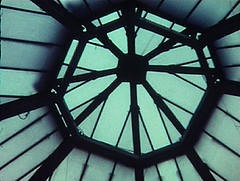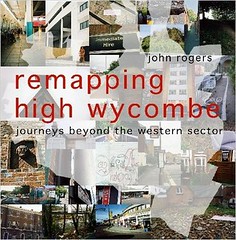Lunchtime Derive Video
This is a video that we shot back in 2004 recording the experience of the Lunchtime Derive. The algorithm that you see in the video (and the idea of algorithmic psychogeography) was developed by Social Fiction.
The aim of the LunchTime Dérive was to study how, by following a simple instruction, a group of workers could re-experience the town during their Lunch Break. The daily hunt for a prawn sandwich or Chicken Tikka Marsala Ready Meal will be replaced with a drift motivated by following a basic algorithm provided Dutch psychogeographers Social Fiction.
In an email to Cathy I sketch out the theoretical background to the exercise and how we might go about organizing it:
According to geographer David Pinder (1996) part of the purpose of the dérive was to allow "participants to drift from their usual activities and to become more aware of their surroundings while simultaneously seeking out ways of changing them."
Our intervention is in part in reference to Chombart de Lauwe's study of the movement's made in a year by a Paris student. Guy Debord referred to the data produced by this study as 'a modern poetry capable of provoking sharp emotional reactions.' By asking the office workers to map their usual lunchtime routines we may find that this precious hour of free time is also similarly limited.
Debord describes the dérive as a period when one or more persons "drop their relations, their work and leisure activities, and all their other usual motives for movement and action, and let themselves be drawn by the attractions of the terrain and the encounters they find there." We will be asking people to drop their usual lunch-time routine of the trip to M&S for a sarnie or surfing the net a their desk and to follow an algorithm wherever it may take them and experience the town as they find it.
We will employ an algorithm to jolt people from their routines and drive the drift most likely taking them into areas they wouldn't normally consider going to at lunch-time. Debord suggests that the dérivers may discover new 'psychogeographical attractions' to which they may be drawn back, in this way our intervention may have deeply subversive consequences in changing the lunch-time habits of a group of office workers, the hunt for grub between 12 and 2 being one of the town's primary motors. By mapping this dynamic then by interfering with it we can start to truly understand and interact with the 'psychogeographical articulations' of the town.
Process:
1. Organize an initial meeting with the workers 1 week or so before the derive. Ask them to map their usual lunchtime movements.
2. On the day of the derive meet the volunteers outside their workplace. Issue them with: notepad, disposable camera, piece of paper containing the algorithm.
3. Make sure that everybody understands the instructions and send the groups of 2-3 people off in different directions.
4. We will accompany the groups to record the event but not intervene. The groups record their route, observations etc. on the notepads.
5. The derive finishes after 30 minutes and we reassemble for lunch and debrief.
6. We collect in notepads and cameras and process the results creating maps of the routes followed.
(we could give them a small amount of money to collect food along the way for the lunch at the end)
Rules for a Dérive
1. One or more persons may dérive
2. The most fruitful numerical arrangement consists of several groups of two or three people.
3. It is preferable for the composition of these groups to change from one dérive to another.
4. Drop your usual motives for movement and action, relations, work and leisure activities.
5. The average duration of a dérive is a day, considered as the time between two periods of sleep.
6. The times of beginning and ending have no necessary relation to the solar day.
7. The last hours of the night are generally unsuitable for dérives.
8. A dérive seldom occurs in its pure form.
9. The spatial field of the dérive may be precisely delimited or vague.
10. The spatial field depends first of all on the point of departure.
11. The maximum area of this spatial field does not extend beyond the entirety of a large city and its suburbs.
12. The minimum area can be limited to a small self-contained ambiance (the extreme case being the static-dérive of an entire day within the Saint-Lazare train station).
Extrapolated from Guy Debord’s 1958 Theory of the Dérive
Labels: algorithmic psychogeography, derive, drift, psychogeography, video, wycombe




2 Comments:
Is algorithmic psychogeography not another name for deep topography? That's what they teach us at the universities these days anyhow.
12:31 pm
I liked the video and like the look of the book. From that and your liking of Robinson in Space, I deduce that you might be interested in www.mythogeography.com.
12:36 pm
Post a Comment
<< Home